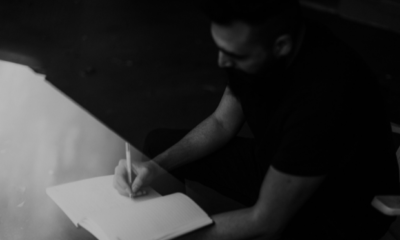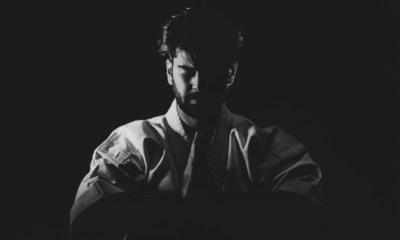Life
Boosting Your Creativity in 3 Easy Steps

“I am simply not creative.” How many times have you said this to yourself or others? I’d imagine quite a few times. Many people believe that creativity is a gift they do not own, a very luxury gift actually, only destined for a select few. I want to break this myth right now and say that creativity is a gift that every single one of us has within ourselves.
The reason why many people do not see it is because they do not allow it to be, they hide it and fear it every single day. Many believe that creativity is only for certain types of people working with art for instance or other creative professions. Albert Einstein said that “Creativity is intelligence having fun.” So every possible intelligent person on this planet can have the chance to be creative and every one of us is intelligent in our own creative way.
Creativity to me is about freedom of expression, freedom of words and behaviour, freedom to be who you truly are and show what you truly love. It is often suppressed because it can be judged as foolish, not being adequate enough, not serious enough, too colourful or too flamboyant. How many times do you wish you could wear that beautiful colourful hat you are keeping in the loft but are too scared to do it as people might think you have gone crazy?
This is a very typical example of how creativity is suppressed daily. Today I want to encourage you to connect deeply to your creativity, to find it, unleash it, and let it be the light in your life. I want to invite you to play with it and start realising that creativity is a gift you have that wants to be expressed and that can be used positively in many areas of your life.
- Creativity can help you stand out in your business.
- Creativity can help you give positivity and fun to your life.
- Creativity can help you connect to your true desires.
- How can you connect to your creativity more?
“The desire to create is one of the deepest yearnings of the human soul.” – Dieter F. Uchtdorf
Here are three easy steps for you:
1. Connect to your inner child
Just close your eyes and go back in time to all the games you used to play and all the activities you used to do as a child. Go back to relive the things you truly loved doing. Were you passionate about colours? Did you use to make clothes or play with marionettes? Maybe your passion was acting, or you always dreamt about flying?
Give a voice to your inner child, let him or her out and play and fully express themselves and bring that expression and passion into your daily life, your ideas and projects. Your life will start to be much more colourful and joyful through using creative imagination.
2. Stop the self-critics
This is such a fundamental step to take if you truly want the creative inner you to come out. Bringing out your creativity can feel scary especially as humans always fear being judged and criticised and have a strong desire to fit in and to comply with the masses.
Ask yourself what is more painful for you, to repress your inner creativity and conform or to be fully creative and possibly not being liked by a few? Put your hand to your heart when you ask yourself this question and see what feels right for you.
“You can’t use up creativity. The more you use the more you have.” – Maya Angelou
3. Stop rushing and start observing more
Creativity will have a tough time coming out if your mind is always busy with stuff, worried, and overthinking about daily problems. Taking time to relax and calm your mind will help you notice the beauty around you. It will help you “see” things you might not see while running around, which could give you lots of creative ideas.
Some of my most creative moments are when I am out in nature watching the leaves moving and the birds flying or simply watching people passing by, without worrying about the whole world. During those moments, your mind is relaxed and can more easily generate ideas and get inspired by the world around you.
One last piece of advice I want to share with you is this: every time you get a creative idea, a creative hit for doing something, creating something, or writing something just do it. The more time you leave before taking action, the more your fears will jump all over your creativity and leave very little left of it. And if that happens, the same old same old boring patterns and ideas will keep dominating in your life.
How do you boost your creative side when you need it? Share your ideas and thoughts with us below!
Life
Imposter Syndrome Is Rooted in Your Past But Here’s How You Can Rewire It
Imposter syndrome is most prevalent in highly successful women

Imposter syndrome is “the persistent inability to believe that one’s success is deserved or has been legitimately achieved as a result of one’s own efforts or skills.” (more…)
Life
The Surprising Mental Health Tool You Probably Haven’t Tried
Through journaling, I arrived at a more balanced perspective, it reinstated my sense of gratitude and led me to accept my disability

In two particularly difficult times in my adult life, my journaling practice is helping me heal emotionally. It has been a vital tool for helping me see the bigger picture and land in a place of gratitude. (more…)
Life
How to Stop Comparing Yourself to Others and Find True Happiness
Comparison is the thief of joy; it robs us of our happiness, self-esteem, and peace of mind

In today’s hyperconnected world, it’s easier than ever to fall into the trap of comparing ourselves to others. Social media platforms like Instagram, Facebook, and LinkedIn constantly bombard us with curated highlights of other people’s lives, making it seem like everyone else is happier, more successful, and more fulfilled than we are. (more…)
Life
Harness the ‘Battery Effect’ to Transform Life’s Tensions into Your Greatest Strength
Recharge your life batteries by shifting your mindset today

I believe our life capacity is determined by the skillsets we develop on this spinning rock we call Earth. By “life capacity,” I mean our ability to embrace and sustain joy. (more…)
-

 Did You Know3 weeks ago
Did You Know3 weeks ago7 Surprising Life Lessons Video Games Taught Me That School Never Did
-

 Success Advice4 weeks ago
Success Advice4 weeks agoHow Playing by the Rules Became the Smartest Business Strategy
-

 Success Advice3 weeks ago
Success Advice3 weeks agoHow to Build Trust, Kill Micromanagement, and Lead a Team That Thrives
-

 Success Advice3 weeks ago
Success Advice3 weeks agoSuccess Isn’t Sexy: 5 Daily Habits That Actually Work
-

 Scale Your Business3 weeks ago
Scale Your Business3 weeks agoHow to Build a Workplace People Actually Want to Show Up To
-

 Scale Your Business3 weeks ago
Scale Your Business3 weeks agoHow Smart Entrepreneurs Cut Financial Chaos in Half with One Simple Switch
-

 Success Advice2 weeks ago
Success Advice2 weeks agoBreaking the Bias: How Females Can Thrive In The Workplace in 2025
-

 Scale Your Business2 weeks ago
Scale Your Business2 weeks agoThis Is How Successful Entrepreneurs Manage Their Time Differently





























